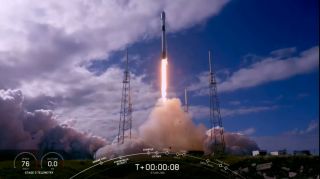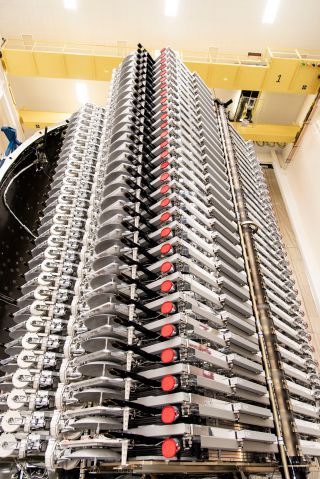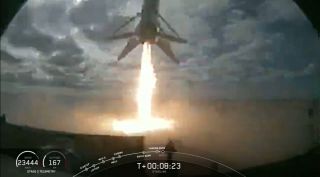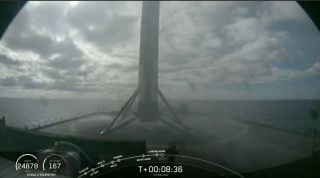SpaceX Just Launched 60 Starlink Satellites (And Nailed a Milestone Rocket Landing) – Space.com
CAPE CANAVERAL, Fla. — SpaceX’s plans to bring global internet coverage to the world just took another leap forward as its 9th Falcon 9 rocket flight of the year launched 60 new Starlink internet satellites into orbit Monday (Nov. 11).
The satellites rode into space atop a veteran Falcon 9 first stage, ending a nearly three-month launch hiatus for the company. The last time a SpaceX Falcon 9 took to the skies, was on Aug. 6, when the company’s flagship rocket carried the Israeli AMOS-17 communications satellite into space.
The sooty Falcon roared to life at 9:56 a.m. EST (1456 GMT), lifting off from Space Launch Complex 40 at Cape Canaveral Air Force Station here in Florida, marking the fourth flight for this particular booster, and the first time a Falcon 9 has flown more than three times.
“The Falcon has landed for the fourth time,” SpaceX Starlink engineer Lauren Lyons, said during launch commentary. “These boosters are designed to be used 10 times. Let’s turn it around for a fifth, guys.”
Related: How to Spot SpaceX’s 60 New Starlink Satellites in the Night Sky
The launch occurred on Veterans Day, a U.S. holiday commemorating military veterans, and SpaceX dedicated the flight to service members. “Liftoff! With gratitude to our veterans today and always,” a SpaceX commentator said. “Go, U.S.A.!”
Following the successful launch, the rocket’s first stage gently touched down on a SpaceX’s drone ship landing platform “Of Course I Still Love You” in the Atlantic Ocean, marking the company’s 45th booster recovery.
Tucked inside the rocket’s nose cone were 60 Starlink satellites — the second batch (and first operational set) of SpaceXs broadband internet megaconstellation, which the company hopes will help provide affordable internet coverage to the world.
Related: SpaceX’s 1st Starlink Megaconstellation Launch in Photos!

A SpaceX Falcon 9 rocket making its fourth trip to space launches 60 new Starlink internet satellites into orbit from Cape Canaveral Air Force Station in Florida on Nov. 11, 2019.
(Image credit: SpaceX)
Increased Connectivity
Currently, internet users rely on wireless cell towers or cables routed into our homes and offices to access the internet. This means that many rural, remote areas around the world are often left without access as the satellites providing coverage are too far away. Many other options for satellite-based internet exist, but can be very expensive and offer slow connecting rates. SpaceX wants to change that.
“This will not only provide internet access to areas that don’t have it, but provide competitive access to areas that already have connectivity,” company CEO, Elon Musk said in a media teleconference prior to the first Starlink launch in May.
Traditional satellite internet providers beam internet coverage down from a high orbital perch, with their satellites stationed in what’s known as geostationary orbit (which is typically 22,000 miles above the Earth). Because the signal has to travel such a long distance, the time it takes to send and receive data is substantially longer and more akin to the days of dial-up.
By operating at a lower altitude — approximately 217 miles (350 km) above the Earth — SpaceX hopes to cut down on this issue and provide reliable coverage at an affordable price.

This SpaceX image shows the 60 Starlink satellites for a Nov. 11, 2019 launch in stacked configuration ahead of launch. It is the heaviest payload for a Falcon 9 yet.
(Image credit: SpaceX)
And SpaceX is not alone. Several other companies (including OneWeb, TeleSat, and now Amazon) want to provide internet to the masses by deploying a network of small satellites in low-Earth orbit, hovering much closer to the Earth than current satellites.
Last month, Musk tweeted via Starlink for the first time. And with as few as six to eight more launches, the company says it could begin offering broadband service in the United States by mid-2020. “We still have a long way to go from tweets to 4K videos, but we are on our way,” company representatives said during Monday’s launch broadcast.
Astronomical Impact
But not everyone is thrilled about SpaceX’s new business venture. Many astronomers are concerned that mega constellations, like Starlink, will impede their research and make it more difficult for amateur astronomers to enjoy the night sky.
When the first batch of satellites launched in May, they were bright enough to see without a telescope as they were easily visible, marching across the sky like a train shortly after launch. Astronomers feared the satellites, which appear as bright as stars, would make it harder to distinguish between the two in the night sky.
Related: Why Astronomers Worry About Brightness of SpaceX’s Starlink Satellites
SpaceX and Musk, tried to reassure concerned astronomers that once the satellites settled into place, they would be less noticeable.
Shortly after the initial batch launched, Musk tweeted that he “sent a note to Starlink team last week specifically regarding albedo reduction,” a measurement that refers to the amount of light reflected by the satellites. Musk also said that both he and SpaceX valued science and would do their part to not impede astronomical research.
Astronomers are anxiously waiting to see what happens with this second batch of satellites and how bright they will appear once they’ve reached their intended orbit.
Although the initial Starlink plan called for a megaconstellation of 12,000 satellites, the company plans for its burgeoning cluster to eventually be more than 40,000 satellites strong. Musk said SpaceX will need at least 400 Starlink satellites in orbit for “minor” broadband coverage, and 800 satellites aloft for “moderate” coverage.
So, with roughly 120 in the sky and thousands more intended to launch, time will tell how troublesome they may or may not be.
Reusability Milestones
This flight marks the first time that SpaceX has flown the same Falcon 9 first-stage booster four times.
The veteran booster flew for the first time just over a year ago. On July 25, 2018, it carried a batch of Iridium satellites into orbit; on Oct. 8, 2018, it lofted the Argentinian Earth-observing satellite SAOCOM 1-A, and on Feb. 22, it ferried the Nusantara Satu Indonesian communications satellite and the Israeli Beresheet lunar lander into space.
Additionally, it marks the first time SpaceX has reused a payload fairing — the rocket’s clamshell-like nose cone that shields the rocket’s contents during launch.
Musk believes that a fully (and rapidly) reusable rocket is the key to dramatically reducing the cost of spaceflight. The company has already shown it can reuse the most expensive portion of the rocket — the first stage — but would like to reuse much more, essentially making fuel the only major expense.

This view from SpaceX’s drone ship landing platform “Of Course I Still Love You” shows a Falcon 9 booster’s first stage as it nears landing on Nov. 11, 2019 after successfully launching 60 Starlink satellites into orbit. .
(Image credit: SpaceX)

The successful landing marked a historic fourth landing (and flight) of a single SpaceX Falcon 9 first stage.
(Image credit: SpaceX)
To that end, SpaceX has transformed two ships (called GO Ms. Tree and GO Ms. Chief) into mobile catcher’s mitts, each outfitted with four arms and a giant net strung in between to attempt to catch the fairing halves as they fall back to Earth. Saltwater is extremely corrosive, so keeping the fairing halves dry, rather than letting them splash down in the Atlantic Ocean, is crucial to reuse.
SpaceX uses identical fairings for its Falcon 9 and Falcon Heavy rockets. Each one costs about $6 million (roughly 10% of the $62 million Falcon 9 price tag) so there’s a significant financial incentive to recover and reuse the fairings. SpaceX fairings are composed of two halves, each of which is equipped with small steering thrusters and parachute-like equipment to aid in recovery efforts.
SpaceX’s efforts finally paid off in June during a Falcon Heavy launch, when one half of the rocket’s nose cone glided into the outstretched arms of the boat GO Ms. Tree (formerly known as Mr. Steven).
Related: SpaceX’s Fairing-Catching Boat in Photos
But that fairing hasn’t been reflown just yet. On Monday, SpaceX reused a fairing recovered from the Atlantic Ocean back in April after it helped a Falcon Heavy deliver the Arabsat-6A communications satellite into space. SpaceX did not specify what sort of refurbishments the fairing halves have gone through or how many times they expect to reuse a recovered fairing.
Both ships deployed in advance of Monday’s launch attempt in hopes of snagging the fairing halves. Unfortunately rough seas thwarted an attempt at another catch.
But with many more Starlink launches on the horizon, fairing reflights could become as common as booster reflights.
Editor’s note: An earlier version of this story incorrectly stated the orbit intended for this Starlink launch. It is 217 miles (350 kilometers), not 341 miles (550 km).
Follow Amy Thompson on Twitter @astrogingersnap. Follow us on Twitter @Spacedotcom or Facebook.

Need more space? Subscribe to our sister title “All About Space” Magazine for the latest amazing news from the final frontier!
(Image credit: All About Space)






